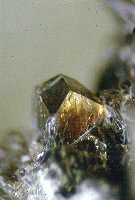 |
|||
|
|||
|
Copyright
Top Ten Reasons
Easy Collecting - Field collecting superb 10cm crystals of a rare mineral isn't particularly easy, but the micromounter can find something of interest almost anywhere. Perfection - Micro crystals are perfectly formed and undamaged far more often than cabinet specimens. They are the peak of aesthetics. Variety - There's only a few hundred minerals out there that come in nice big crystals, and almost no new species are found in sizeable crystals. Go to any mineral show and what do you see - table after table of aquamarine, quartz, and fluorite. Micromounters work with far more species than hand-specimen collectors, and are familiar with far more rarities. Low Prices - The average price of a micromount is $3. Really expensive ones are $20. The initial expense of a good scope and proper light is pretty steep, but after that you're set. No Fakes - When a lot of money is changing hands for a fine cabinet piece, one has to be wary that the specimen hasn't been altered or faked in some way. Faking micromounts is not only extremely rare, it's nearly impossible, as a microscope easily reveals glue where it shouldn't be. Cheap Shipping - Sending 100 micromounts by airmail to Europe is far more affordable than 100 cabinet pieces. Year Round Fun - A large part of what drives field collectors is the thrill of discovery. The micromounter with a good hoard of material doesn't have the constraints of a field season - no matter what the weather is like he can pull some rocks out of storage, trim them down, and find fantastic crystal-filled vugs never before seen by man. The micromounter can delve through his stock of material and find new stuff any day of the week, and he can go collecting in his basement even if it's 2:00 AM and 20 degrees below outside. It's a year round hobby. Weird & Wonderful - The micromounter sees things that aren't even imagined by 'macro' collectors. Things like spiral millerite crystals, Sweet Home Mine rhodochrosite rhombs with moving bubble inclusions, or minerals like rutile, pyrite, and boulangerite in ring crystals, to name a very few of the bizarre things seen by the micromounter. Free Stuff! - Last time you went to your average, garden-variety mineral show, did they have tables filled with fine cabinet specimens free for the taking? At micromount symposia, give-away tables loaded with interesting stuff are standard practice. Micromounters are a very generous bunch!
Permission is given to freely reprint this article from the Canadian Rockhound for non-commercial and educational purposes, provided the author and the Canadian Rockhound are acknowledged, and that the website URL address of the Canadian Rockhound is given. The article may not be edited or rewritten to change its meaning or substance without the author's permission. To contact the author, please use the e-mail address provided.
|
||||

Copyright © 1999 Canadian Rockhound
Magazine Issues |
News & Events |
Junior Rockhound |
Resources
|
|||||
